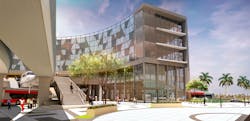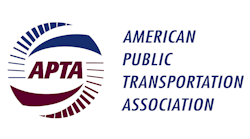As chair of the American Public Transportation Association, one of Jacksonville Transportation Authority CEO Nathaniel P. Ford Sr.’s five priorities is how the industry needs to adapt to the new mobility paradigm. He has a holistic vision that will position the industry where the surface transportation community will move people in the most efficient way in shared mobility.
Priorities as APTA Chair
- Leadership and Advocacy
- Mobility Paradigm
- Workforce of the Future
- Leveraging Data-Driven Business Models
- Enterprise Risk Management
JTA is an example of that as it is preparing for the future. “We didn’t end up here overnight,” Ford stressed. “Everything we’re doing … was years of work that laid the foundation that we could take on these bold challenges.”
To meet these challenges, there were changes to the hiring process and how they use leadership characteristics to bring on the right team. “It really boils back down to the talent and the people we have here at the JTA,” Ford stressed.
Mulitmodal Development
Serving as the mobility hub, the state-of-the-art Jacksonville Regional Transportation Center will feature a bus terminal for JTA’s bus rapid transit First Coast Flyer and fixed-route service, an Intercity Bus Terminal for Greyhound and Megabus, JTA’s Skyway, future commuter rail, taxi service, transportation network companies, bicycle and pedestrian amenities, and the JTA Administrative Building.
The first phase of the project is the Intercity Bus Terminal. JTA owns the facility and will lease it to Greyhound, Megabus and any other intercity bus operator. Construction started February 2017 and will be completed in February 2018. Phase 2, scheduled for completion in 2020, will be the JTA Administration Building and JTA Bus Transfer Facility.
Bus Transfer Facility
- Covered bays for 21 buses
- ADA-accessible single continuous platform
- Enclosed passenger waiting area
- Ticket vending machines
- Operator lounge
- Public restrooms
- Lost and found area and customer service
The $58 million project is 100 percent funded through the JTA, the Federal Transit Administration and the Florida Department of Transportation.
LaVilla, the community where the JRTC is being built, is an area that has been depressed and between the city and JTA, there are numerous parcels that they own and are working with the city and the Downtown Investment Authority to develop a transit-oriented development redevelopment plan. “That study is underway right now,” Ford said.
He mentioned a part of the revitalization of LaVilla as a downtown neighborhood was the Lofts at LaVilla, an affordable housing complex that had a waiting list of prospective tenants while still under construction. The $22 million project is a 130-unit affordable housing apartment building.
The JTTC project will include improvements to the Skyway Convention Center Station, roadway, sidewalk and landscaping.
The Future of Mobility
The Skyway was developed almost 30 years ago as an experimental project – autonomous, monorail-type vehicle operations. “You had Miami, you had Detroit and you had the JTA who were successful in receiving those grants,” said Ford. “We eventually built a 2.5-mile system and unfortunately that system was never expanded, for various reasons: political will wasn’t there, the funding wasn’t there, it literally got cut short from its original design plan.”
In 2014 the JTA implemented its Route Optimization Initiative, a total system overhaul. “When we did that overhaul of the fixed-route system, we integrated the Skyway as part of the operation,” Ford said. “Prior to that, it was almost like a stand-alone operation. It was clearly designed for mobility in downtown from the parking garages to the office buildings, but again, it did not reach its full potential.”
The Skyway ridership started growing once it was an integrated part of the system and they began discussion on the future of the Skyway. The vehicles were part their useful life and it was getting more and more difficult to maintain them.
A Skyway advisory committee was created to take an in-depth look at the operation. In December 2015, the board approved a resolution to keep, modernize and expand the Skyway, based on input from the skyway advisory committee and the public.
The Skyway Modernization Program was developed in 2016 and in February 2017, the board approved the recommendations and staff began work on the development of the Ultimate Urban Circulator Program: U2C.
The Skyway has antiquated technology and a very costly aerial structure. As it’s not at ground level, people can’t hop on and off in a downtown environment. Ford said, “The gains that you have in terms of being aerial and above traffic, you kind of lose from an economic activity standpoint or a downtown vitality standpoint.”
“I think the lightbulb went off that our Skyway is already an autonomous vehicle; it’s been an autonomous vehicle for 30 years.” He continued, “The challenge is, because it’s a monorail, it can’t operate at street level. And if there were a way to get it to street level and operate autonomous vehicles, we could easily expand the system and would add the flexibility to the future to change routes … as communities change or as cities and developments change in downtown …”
JTA will pull out the monorail beam, create a smooth roadway surface, build ramps to take it from an aerial structure down to street level and operate in the street in dedicated lanes, and eventually in mixed traffic as the autonomous technology develops.
JTA opened a test track in December, located on the access road adjacent to the Sports Complex/Daily’s Place and the Doro District, in partnership with the city of Jacksonville, the Sports Management Group, the Jacksonville Sheriff’s Office and the Jacksonville Jaguars.
The currently are testing the EasyMile EZ10 vehicle. EasyMile is building a second version vehicle that will be starting in February. JTA will test operations over the next two years, rotating vehicles every six months from the various vendors. Ford said they will be implementing robust testing of the vehicles to ensure they can withstand all of the environmental conditions and the operating conditions they need to be concerned with.
“I think we have a bit of a head start because for 30 years we’ve been operating autonomous vehicles, it’s just that it’s been restricted to an aerial structure with a monorail beam,” said Ford. “Once we modify that and get to street level, now it’s a decision of what type of vehicle and dealing with some of the technological vehicle control systems; we’re fast becoming a technology company.”
The flexibility will allow JTA to quickly expand into planned development, such as the 70 acres of riverfront property being redeveloped by Iguana Investments Florida, which is expected to have 300 to 500 condominiums, 300 to 500 apartments, 300,000 to 500,000 square feet of office space, 150,000 to 250,000 square feet for retail and restaurants and 200 to 500 hotel rooms at full build-out.
“We are also working from an administrative standpoint, government relations standpoint, to look at legislation related to the operation of autonomous vehicles, not just here in Jacksonville, but in Florida and at the national level,” Ford said, “because there’s a lot of activity underway and we want to make sure the rules that are written and the policies, the funding models as it relates to the FTA and DOT, is supportive of our project.
“We’re working very closely with Jane Williams, the acting FTA administrator and we’ve also shared this information with Secretary Chao, in terms of what we’re doing here in Jacksonville.” He continued, “They’re very familiar with this project and the idea is, in the FTA’s model, how does an autonomous vehicle fit in from a funding standpoint and a governance standpoint? We’re all learning together.”
Ford said, “It gets back to one of my platforms as it related to this new shared mobility paradigm that we’re facing … I want to run my system as efficiently as possible and with a 40-foot bus, one size doesn’t fit all.
“If I’m able to partner with Uber or Lyft or a local tax company to carry those trips that are very inefficient for me to provide, it’s unfortunate that is not included in my annual ridership.” He added, “And in fact, my ridership may grow because of one of these services in some areas.”
One Size Doesn’t Fit All
An example of improving efficiency resulting in a loss of ridership numbers is JTA’s Beaches Community Shuttle, a flexible-route shuttle in the Neptune Beach and Atlantic Beach area that connected to the fixed-route service.
The service was sparingly used and a private company, Beachside Buggies, started up, operating golf carts providing door-to-door service. It was a hop-on, hop-off-type of service and was doing very well.
“We looked at their model and their operation and we basically poached them and made a decision to terminate our beaches trolley and subsidize the beachside buggies,” explained Ford.
At a fraction of the cost, they were able to subsidize year-round operation of Beachside Buggies, as opposed to the seasonal offering of the Beaches Community Shuttle. JTA also purchased a couple of ADA-accessible golf carts for the operation.
“But the thing is, Beachside Buggies ridership does not count to the JTA,” said Ford.
“It works against the grain. We as transit systems need to look at the most efficient way to move people and I think in this particular case, this further helps me … our responsibility is to share mobility, moving people using various different modes, whether they’re biking, walking, using Beachside Buggies, taxis.
“We need to step away from looking at ‘bus’ and ‘rail’ and ‘paratransit’ and look at the entire gamut as it looks at transportation,” Ford said.
“I think that’s where APTA comes in and can really help us advocate at the federal level in terms of funding related to mobility vs. related to specific modes because I think the paradigm we’re stuck in today does not encourage — or does not reward — some of the creative solutions that we’re looking at nowadays, so it makes it very difficult for us to compete with the Uber, Lyfts or Googles.”
“Folks like myself that are pushing the envelope and raising these issues, such as ridership that is becoming more efficient by becoming more diverse … I jeopardize the funding that I receive to operate my system.”






